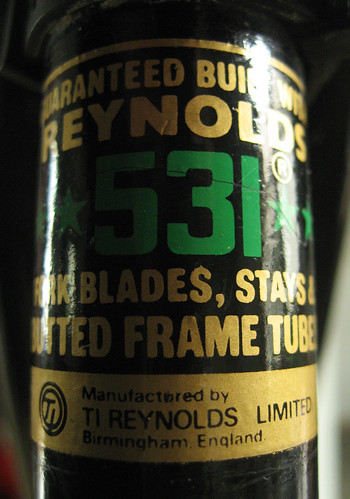I’ve remarked before (and probably will again) on some of the underlying similarities between bicycles and shotguns. And yet there’s a huge corpus around firearms (yr humble’s correspondent’s collection here), but nothing comparable in size and scope on the bicycle side. Perhaps the gun’s 500 year head start is responsible, but my gut tells me something else is going on. Be that as it may, It’s All about the Bike is a welcome addition to the not-large-enough-by-half bike as object genre. Robert Penn’s book is the story of his dream bike; he wanted a bike that was just so – not the absolute best of everything, rather the absolute best for his purposes. The book leads us through the choices he made, component by component. Along the way he detours into history – his past and the bicycle’s past – to flesh out the hows and whys of his decisions. Take frame material for example:
Crucially, steel can be repaired anywhere in the world by a man with a blowtorch and a welding rod. I know this, because I bent a steel bike in northern India, when I was riding around the world. I was slipstreaming a tractor on the Grand Trunk Road near Amritsar.We were going downhill a lick when I road into a pothole the size of a hot tub. There was no time to react. I had what American mountain bikers call a ‘yard sale’. The bike, panniers, sunglasses, water bottles, tent, pump, map and I were strewn across the tarmac. […] It took me an afternoon to find the best mechanic, or ‘top foreman’ as the locals called him, in Amritsar. Expertly, he removed the handlebars, the stem, the forks and the stressed headset from the head tube, while attendants handed him tools as a nurse attends a surgeon. Then he shoved a metal spike through the head tube and literally bashed the tubes straight again. It was terrifying to watch.
The frame requires a bit more attention on the remaining 7,500 miles, but gets him home. And:
In the alchemy of designing aircraft tubing, Reynolds stumbled on a manganese-molybdenum alloy that made wonderful bikes. In 1935, the company introduced ‘531’ tubing. It was considered revolutionary. Even now, British [and American] cyclists of a certain age go misty eyed and look towards the horizon just at the mention of ‘531’.
*
You get a taste in the quotes above both of the range of Mr. Penn’s inquiry and of his writing style. I found the book to be thoroughly enjoyable; style and subject both get an A. It’s a quick read – 198 pages of clear prose – and if you like bikes, highly recommended.
Two additional notes: 1) In spite of my pissing and moaning about the volume of bike lit, I recently bought a fantastic book of visual bike history (aka bike prØn). The Golden Age of Handbuilt Bicycles is a survey of mostly-French mostly-randonneur bicycles from 1909 – 2003. Inspirational – especially as regards a: 2) Current project – I’m assembling a dream bike as well. I’ll post more in a month or so; I’ve built what I’m calling a voyageur bike on a touring frame – pictures/specifications/rationales to follow once the new ride is fully dialed in.
Partially cross-posted to LibraryThing.


Whoa! a bike geek, too! Lovin’ the ride.
The French (of course) company that made my light double 16 gauge, Manufrance, made only shotguns and bikes– even says so on the barrel!
A Manufrance gentleman’s hunting cycle! http://manufrance.wordpress.com/1951-manufrance-hirondelle-vap4-gentleman%E2%80%99s-hunting-cycle/